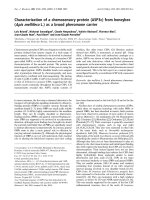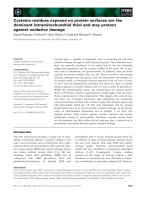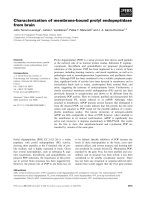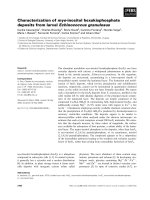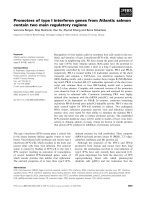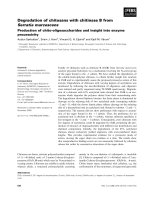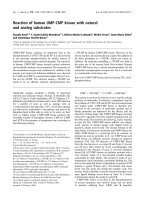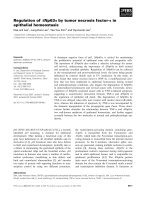Báo cáo khoa học: "Influence of shade on photosynthetic gas exchange of 7 tropical rain-forest species from Guadeloupe (French West Indies)" docx
Bạn đang xem bản rút gọn của tài liệu. Xem và tải ngay bản đầy đủ của tài liệu tại đây (848.65 KB, 18 trang )
Original
article
Influence
of
shade
on
photosynthetic
gas
exchange
of
7
tropical
rain-forest
species
from
Guadeloupe
(French
West
Indies)
M
Ducrey
INRA,
Laboratoire
de
Recherches
Forestières
Méditerranéennes,
avenue
A-Vivaldi,
F-84000
Avignon,
France
(Received
16
November
1992;
accepted
21
September
1993)
Summary —
Young
seedlings
from
7
tropical
rain-forest
species
of
Guadeloupe
(French
West
In-
dies):
Dacryodes
excelsa,
Amanoa
caribaea,
Richeria
grandis,
Simaruba
amara,
Symphonia
globu-
lifera,
Byrsonima
coriacea
and
Podocarpus
coriaceus
were
grown
for
1-2
yr
in
full
sunlight
or
under
4
artificially
shaded
tunnels
transmitting
6,
11,
19
and
54%
daylight.
Photosynthetic
gas
exchanges
of
attached
leaves
or
branches
were
then
studied
in
the
laboratory.
Net
photosynthesis-light
curves
were
analysed
for
an
average
of
4
seedlings
per
species
and
per
light
treatment.
Maximum
photo-
synthesis
on
a
leaf-area
basis
of
sungrown
seedlings
varied
from
3.4
μmol
CO
2
m
-2
s
-1
for
Da-
cryodes
excelsa
to
7.9
μmol
CO
2
m
-2
s
-1
for
Simaruba
amara.
For
all
the
species
studied
and
when
the
measurements
were
expressed
on
a
leaf-area
basis,
maximum
photosynthesis
of
sun-grown
seedlings
was
higher
than
for
shade-grown
seedlings.
The
opposite
was
observed
for
photosynthe-
sis
under
limited
light
and
for
apparent
quantum
yield.
We
also
observed
a
decrease
in
maximum
photosynthesis
and
an
increase
in
apparent
quantum
yield
when
specific
leaf
area
increased,
ie
when
the
plants
were
more
shaded.
The
range
of
variation
in
photosynthetic
response
between
full
sunlight
and
full
shade
made
it
possible
to
characterize the
photosynthetic
plasticity
of
the
species.
The
results
were
compared
with
those
obtained
for
other
tropical
rain-forest
species.
They
are
dis-
cussed
in
terms
of
photosynthetic
and
morphological
plasticity,
shade
adaptation,
and
of
the
species’
place
in
tropical
rain-forest
succession.
tropical
rain
forest
I
forest
succession
I
shade
tolerance
I
net
photosynthesis
I
photosyn-
thetic plasticity
Résumé —
Influence
de
l’ombrage
sur
les
échanges
gazeux
photosynthétiques
de
7
espèces
de
la
forêt
tropicale
humide
de
Guadeloupe
(Petites
Antilles).
De jeunes
semis
de
7
espèces
de
la
forêt
tropicale
humide
de
Guadeloupe
(Petites
Antilles) :
Dacryodes
excelsa,
Amanoa
caribaea,
Richeria
grandis,
Simaruba
amara,
Symphonia
globulifera,
Byrsonima
coriacea
et
Podocarpus
coria-
ceus
ont
été
élevés
pendant
1
à
2
ans
en
pleine
lumière
et
sous
4
tunnels
artificiellement
ombragés
laissant
passer
6%,
11%,
19%
et
54%
de
la
pleine
lumière.
À
la
fin
de
cette
période,
on
a
étudié
au
laboratoire
les
échanges
gazeux
photosynthétiques
de
feuilles
ou
de
rameaux
rattachés
aux jeunes
plants.
Des
courbes
photosynthèse
nette -
éclairement
ont
ainsi
été
réalisées
en
moyenne
pour
4
plants
par
espèce
et par
tunnel.
La
photosynthèse
maximale
des
plants
de
pleine
lumière
varie
de
3,4
μmol
CO
2
m
-2
s
-1
pour
Dacryodes
excelsa à
7,9
μmol
CO
2
m
-2
s
-1
pour
Simaruba
amara.
Pour
toutes
les
espèces
étudiées
et
lorsque
les
mesures
sont
rapportées
à
l’unité
de
surface
foliaire,
la
photosynthèse
maximale
des
plants
de
pleine
lumière
est
supérieure
à
celle
des
plants
d’ombre,
tan-
dis
que
l’on
observe
l’inverse
pour
la
photosynthèse
en
éclairement
limitant
et
pour
le
rendement
quantique
apparent.
On
note
parallèlement
une
diminution
de
la
photosynthèse
maximale
et
une
aug-
mentation
du
rendement
quantique
apparent
lorsque
la
surface
spécifique
des
feuilles
augmente,
c’est-à-dire
quand
les
plants
sont
de
plus
en
plus
ombragés.
L’amplitude
des
variations
de
photosyn-
thèse
entre
la
pleine
lumière
et
le
plus
fort
ombrage
permet
de
caractériser
la
plasticité
photosynthéti-
que
des
espèces.
Les
résultats
sont
comparés
à
ceux
obtenus
avec
d’autres
espèces
forestières
de
la
zone
tropicale
humide.
Ils
sont
enfin
discutés
en
termes
de
plasticité
morphologique
et
photosyn-
thétique,
d’adaptation
à
l’ombrage,
et
d’emplacement
dans
le
cycle
de
succession
des
espèces
dans
les
forêts
tropicales
humides.
forêt
tropicale
humide
/
succession
forestière
/
tolérance
à
l’ombrage
/
photosynthèse
nette
/
plasticité
photosynthétique
INTRODUCTION
The
morphological,
anatomical,
structural,
ultrastructural,
biochemical
or
photosyn-
thetic
response
of
herbaceous
species
and
shrubs
to
different
light
conditions
dur-
ing
growth
is
well
known
(eg,
Boardman,
1977;
Björkman,
1981;
and
Givnish,
1988).
In
general,
the
light-saturated
rate
of
photosynthesis,
the
light
compensation
point,
and
the
light
saturation
plateau
are
higher
for
sun-grown
plants
than
for
shade-grown
plants.
On
the
other
hand,
sun-grown
plants
have
leaves
with
a
lower
specific
area,
and
which
contain
smaller
chloroplasts
than
shade-grown
plants.
Most
of
the
responses
described
above
are
also
applicable
to
trees,
but
the
re-
sponses
of
trees
may
be
modified
because
of
their
variable
social
status
within
a
forest.
For
example,
sun-shade
responses
within
a
tree
may
be
different
from
sun-shade
re-
sponses
of
seedlings
of
the
same
species
(Leverenz
and
Jarvis,
1980).
It
is
also
im-
portant
to
investigate
sun-shade
adapta-
tion
at
the
genotype
level.
The
sun-shade
responses
can
be
ex-
pressed
by
different
degrees
of
shade
tol-
erance,
and
have
long
been
used
by
foresters
in
the
silvicultural
management
of
forest
stands.
Baker’s
(1949)
tables
of
tol-
erance
for
conifers
and
hardwood
species
of
North
America
are
an
example.
Generally,
shade-intolerant
forest
spe-
cies
are
characterized
by
higher
photosyn-
thetic
potentials
than
those
of
shade-
tolerant
species.
However,
what
differen-
tiates
the
species
and
makes
it
possible
to
classify
them
in
relation
to
one
another,
is
the
possible
capacity
for
intolerant
species
to
tolerate
more
or
less
shade,
and
for
tol-
erant
species
to
survive
in
high
light
condi-
tions.
When
a
species’
forest
behavior
is
em-
pirically
known,
then
it
is
usually
possible
to
explain
its
photosynthetic
capacities
and
its
morphology
in
terms
of
shade
tolerance
(see,
for
example,
Tsel’Niker,
1977;
Baz-
zaz
and
Carlson,
1982;
McMillen
and
McClendon,
1983,
among
others).
How-
ever,
when
there
is
no
empirical
knowl-
edge
for
a
given
species
of
its
ecology
or
its
silvicultural
behavior,
is
it
possible
to
de-
duce
the
degree
of
shade
tolerance
simply
from
its
photosynthetic
capacities
and
its
reactions
to
experimental
variations
in
light
environment?
This
question
is
fundamental
for
a
wide
variety
of
forest
species
which
make
up
the
tropical
rain
forest
and
about
which
we
have
almost
no
silvicultural
knowledge.
In
unmanaged
tropical
rain
forests,
the
presence
of
a
species
in
a
particular
place
at
a
particular
time
is
almost
always
condi-
tioned
by
its
response
to
light.
Of
course,
it
also
depends
on
other
factors,
such
as
seed
availability,
dispersal
and
germination
of
these
seeds,
competition
and
allelo-
pathy
processes,
or
edaphic
conditions.
This
is
the
way
the
species’
succession
cy-
cle
is
developed
from
pioneer
species,
which
require
high
quantities
of
light,
which
are
generally
shade
intolerant,
and
which
colonize
open
space,
to
species
of
stable
adult
stands,
which
are
generally
more
shade
tolerant
when
young
(Whitmore,
1978;
Rollet,
1983).
The
opening
of
these
stable
stands
by
natural
wind-fallen
wood
or
partial
harvesting,
creates
gaps
whose
size
(ie
light
conditions
as
well)
partially
determines
which
species
will
be
able
to
establish
themselves.
The
problem
of
species
succession
and
shade
tolerance
has
been
posed
for
the
Guadeloupe
tropical
rain
forest
where
we
conducted
silvicultural
studies
on
7
com-
mercially
interesting
species.
The
objective
was
to
favor
natural
regeneration
of
these
species
(Ducrey
and
Labbé,
1985).
The
study
of
the
seedlings
in
relation
to
the
in-
tensity
of
regeneration
fellings
gave
us
pre-
liminary
information
about
light
response
of
the
species
whose
regeneration
was
in-
duced
by
silvicultural
treatment
(Ducrey
and
Labbé,
1986).
To
improve
this
infor-
mation,
we
cultivated
seedlings
from
7
for-
est
species
under
semi-controlled
light
conditions
under
differently
shaded
tunnel
greenhouses.
In
a
previous
article
(Ducrey,
1992),
we
studied
the
morphological
varia-
tions
of
the
leaf
system
in
relation
to
shade.
In
this
paper,
we
shall
examine
the
photosynthetic
response
of
the
seedlings
of
these
7
species
cultivated
under
5
differ-
ent
shade
environments.
We
shall
also
try
to
answer
the
following
question.
Can
a
species’
shade
tolerance
be
predicted
by
the
photosynthetic
response
of
seedlings
of
that
species
grown
under
a
range
of
light
environments?
PLANT
MATERIAL
AND
STUDY
METHOD
Species
studied
and
seedling
growth
conditions
The
seedlings
used
for
the
experiment
were
sampled
from
the
tropical
rain
forest
of
Guade-
loupe,
French
West
Indies,
in
the
Caribbean
Is-
lands.
They
come
from
the
area
called
"Débau-
chée"
(Ducrey,
1986)
at
an
elevation
of
250
m.
Mean
temperatures
were
23°C
for
January
and
26°C
for
July.
Mean
annual
rainfall
was
more
than
3
000
mm.
There
was
a
short
dry
season
from
January
to
April,
where
monthly
rainfall
was
always
greater
than
100
mm.
The
7
species
studied
were
evergreen
domi-
nant
and
co-dominant
trees
from
middle
and
late
successional
cycle
of
the
Guadeloupe’s
rain
forest.
Dacryodes
excelsa
Vahl,
Amanoa
cari-
baea
Kr
and
Urb,
and
Podocarpus
coriaceus
LC
Rich
are
late
successional,
shade-tolerant
spe-
cies.
Simaruba
amara
Aubl
and
Richeria
grandis
Vahl
are
mid-successional,
shade-intolerant
species.
Byrsonima
coriacea
is
present
in
mid-
and
late
succession,
whereas
Symphonia
globu-
lifera
L,
a
wet
soil
specialist,
is
a
late
succes-
sional
species.
However
the
shade
reaction
of
these
2
species
is
not
well
known.
The
seedlings
were
generally
aged
1
yr,
har-
vested
from
the
forest
margin
in
January
1981,
and
transplanted
to
9-I
pots
filled
with
soil
from
the
upper
horizon
of
the
forest
floor.
The
pots
were
placed
under
a
forest
canopy
to
ensure
a
better
recovery.
After
3
months,
the
pots
were
transferred
to
tunnel
greenhouses,
15
m
long
and
6
m
wide,
covered
with
shade
cloth
trans-
mitting
the
amount
of
light
desired.
The
same
procedure
was
applied
to
all
species
except
P
coriaceus
whose
seedlings
were
all
placed
in
the
same
tunnel
in
March
1981
and
then
distrib-
uted
to
the
different
tunnels
in
January
1982,
and
A caribaea
which
was
started
1
yr
later
in
March
1982.
The
seedlings
were
regularly
wa-
tered
twice
a
week.
No
fertilizer
was
used
dur-
ing
the
experiment.
The
seedlings
were
separated
into
5
treat-
ments:
4
treatments
under
plastic
tunnels
and
1
open
air,
full
sunlight
treatment.
The
4
tunnel
shelters
were
covered
with
reinforced
transpar-
ent
PVC
to
protect
against
rainfall.
Three
of
them
were
shaded
with
different
black
neutral
shade
screens
in
order
to
obtain
various
shade
conditions.
Finally,
global
radiation
measure-
ments
with
Li-Cor,
Li
200
pyranometers
indi-
cates
6.4%
light
under
tunnel
I,
11.4%
light
un-
der
tunnel
II,
18.8%
light
under
tunnel
III,
and
54.3%
light
under
tunnel
IV.
Table
I shows
climatic
data
under
tunnel
shelters.
These
were
opened
and
oriented
in
the
direction
of
prevailing
winds.
The
tempera-
ture
and
humidity
of
the
air
under
the
tunnels
were
the
same
as
those
in
the
open-air
treat-
ment
(meteorological
data
measured
with
a
weather
station),
except
for
tunnel
IV
whose
maximum
temperatures
were
slightly
higher
than
in
the
others.
In
fact,
the
shade
under
this
tunnel
was
created
using
only
a
reinforced
trans-
parent
plastic
cover
which
caused
a
more
signifi-
cant
warming
effect.
Because
of
only
small
cli-
matic
differences
between
experimental
treatments
and
additional
watering,
we
can
con-
sider
that
light
is
the
major
variable
between
the
5
treatments.
Measurements
of
net
photosynthesis
Photosynthesis
measurements
took
place
from
the
end
of
October
to
the
end
of
December
1982.
The
seedlings
were
kept
under
the
experi-
mental
light
conditions
for
close
to
2
yr
(except
for
A
caribaea
and
P
coriaceus
which
were
kept
for
only
1
yr)
and
all
the
leaves
measured
were
initiated
and
grown
under
the
treatment
condi-
tions.
These
leaves
could
be
considered
as
be-
ing
completely
acclimated
to
the
experimental
light
conditions.
Measurements
were
made
on
fully
developed
leaves.
The
mean
size
of
the
seedlings
used
in
photosynthesis
measure-
ments
is
shown
in
table
II.
The
measurements
of
net
photosynthesis
were
carried
out
in
the
laboratory
on
attached
leaves
or
branches
placed
in
a
ventilated
cham-
ber,
perpendicular
to
the
light
source.
The
measurement
of
carbon
dioxide
exchange
was
made
in
an
open
system
using
an
infrared
differ-
ential
gas
analyser
of
carbon
dioxide
(ADC
mod-
el)
which
measured
the
difference
in
CO
2
con-
centration
between
the reference
circuit
and
the
measured
circuit.
The
temperature
was
set
be-
tween
25 and
27°C
using
a
water
cooling
sys-
tem
where
the
measurement
chamber
was
sub-
merged
in
a
tank
containing
cooled
water.
Relative
humidity
of
the
air
was
maintained
be-
tween
70
and
90%
by
bubbling
air
into
a
water
flask
maintained
at
the
temperature
of
the de-
sired
dew
point.
Lighting
was
achieved
using
a
mobile
stand
of
tungsten-halogen
quartz
lamps
with
a
unit
power
of
1
000
W.
Photosynthetic
active
radia-
tion
was
measured
with
a
Li-Cor,
LI
190
quan-
tum
sensor.
Four
light
levels
were
used:
28
and
56
μmol
m
-2
s
-1
for
low
light;
368
and 632
μmol
m
-2
s
-1
for
saturating
light.
A
few
measurements
were
also
taken
at
924
μmol
m
-2
s
-1
,
but
the
re-
sults
were
always
less
than
or
equal
to
those
at
632
μmol
m
-2
s
-1
.
We
thus
considered
that
satu-
ration
was
reached
between
368
and
632
μmol
m
-2
s
-1
,
and
we
did
not
use
the
data
for
924
μmol
m
-2
s
-1
.
Gas
exchange
measurements
were
made
first
in
darkness
to
calculated
dark
respiration
and
then
with
increasing
light
levels.
The
area
and
dry
weight
of
the
leaves
stud-
ied
were
also
calculated.
This
made
it
possible
to
calculate
photosynthesis
per
unit
of
leaf
area
and
per
unit of leaf
dry
matter,
and
to
determine
the
specific
leaf
area
(ratio
between
leaf
area
and
leaf
dry
weight)
of
the
leaves
studied
(table
III).
Dark
respiration
and
photosynthesis
in
low
light
made
it
possible
to
determine
the
initial
slope
of
the
net
photosynthesis-light
curves
which
is
called
apparent
quantum
yield
and
which
approximates
to
the
quantum
yield
of
the
leaf
(number
of
moles
of
CO
2
assimilated
per
mole
of
photons
absorbed
by
the
leaf)
except
that
only
incident
photon
flux
density
was
measured.
Light-saturated
net
photosynthesis
was
then
calculated
as
an
average
of
photosynthesis
val-
ues
recorded
at
368 and
632
μmol
m
-2
s
-1
.
In
the
same
way,
light-limited
net
photosynthesis
is
an
average
of
photosynthesis
values
recorded
at
28
and
56
μmol
m
-2
s
-1
.
An
average
of
4
seedlings
per
tunnel
and
per
species
were
used,
representing
a
total
of
147
plants
and
147
net
photosynthesis-light
curves.
The
4
variables
defining
the
147
net
photosyn-
thesis-light
curves
carried
out
for
this
study
were
analysed
by
an
analysis
of
variance
with
1
fac-
tor,
Tunnel,
for
each
species.
Differences
be-
tunnels
were
set
out
with
a
Duncan’s
test
of
multiple
mean
comparisons.
Relationships
between
these
4
variables
and
relative
light
in-
tensity
were
analysed by
linear
regression,
spe-
cies
by
species,
on
raw
data.
RESULTS
The
results
shown
in
table
IV
represent
data
recorded
per
unit
of
leaf
area;
those
in
table
V
show
data
recorded
per
unit
of
dry
matter.
To
facilitate
the
interpretation
of
these
results,
we
combine
the
net
photo-
synthesis-light
curves
for
each
species
in
dense
shade
(tunnel
I,
6%
relative
light
in-
tensity)
and
full
sunlight
(tunnel
V,
100%
RLI)
in
figure
1.
Light-saturated
net
photosynthesis
For
plants
grown
in
full
sunlight,
light-
saturated
photosynthesis
recorded
per
unit
of leaf
area
was
the
highest
for
S amara
μmol
m
-2
s
-1
)
and
the
lowest
for
D
ex-
celsa
(3.4
μmol
m
-2
s
-1).
Photosynthesis
recorded
per
unit of
dry
matter
was
then
65
nmol
g
-1
s
-1
for
S amara
and
35
nmol
g
-1
s
-1
for
D
excelsa.
The
other
species
had
intermediate
values.
Whether
photo-
synthesis
was
recorded
per
leaf
area
or
dry
matter
units,
the
species
ranking
was
approximately
the
same.
The
small
amount
of
change
was
due
to
small
differ-
ences
in
specific
leaf
area
between
spe-
cies,
for
plants
grown
in
full
sunlight.
For
plants
grown
in
shady
conditions,
light-saturated
photosynthesis
recorded
unit
of
leaf
area
showed
a
general
trend,
decreasing
from
light
shade
(tunnel
IV,
54%
RLI)
to
heavy
shade
(tunnel
I, 6%
RLI).
Some
species,
like
S
amara,
reacted
more
strongly
than
others
to
changes
in
light
regime,
as
shown
in
figure
1.
An
opposite
trend
was
found
when
photosyn-
thesis
was
recorded
in
dry
matter
units.
Photosynthesis
is
then
higher
for
plants
under
heavy
shade
(tunnels
I,
II
and
III,
6-19%
RLI)
than
for
plants
under
light
shade
(tunnel
IV,
54%
RLI)
or
in
full
sun-
light.
Light-limited
net
photosynthesis
For
plants
grown
in
full
sunlight,
light-
limited
photosynthesis
on
a
leaf
area
basis
was
the
highest
for
S
globulifera
(1.8
μmol
m
-2
s
-1
)
and
the
lowest
for
D
excelsa
(0.8
μmol
m
-2
s
-1).
Photosynthesis
record-
ed
per
unit of
dry
matter
was
then
23
nmol
g
-1
s
-1
for
S
globulifera
and
9
nmol
g
-1
s
-1
for
D
excelsa
and
P
coriaceus.
The
other
species
had
intermediate
values.
For
plants
grown
under
different
shade
treatments,
light-limited
photosynthesis
on
a
leaf-area
basis
decreased
from
deep
shade
(tunnel
I,
6%
RLI)
to
light
shade
(tunnel
IV,
54%
RLI),
the
lowest
values
be-
ing
encountered
in
full
sunlight.
At
a
spe-
cies
level,
this
trend
was
not
always
true
because
of
high
data
variability.
This
trend
appeared
clearly
for
most
of
the
species
when
photosynthesis
was
recorded
per
unit
of
dry
matter.
Apparent
quantum
yield
For
plants
grown
in
full
sunlight,
apparent
quantum
yield
was
the
highest
for
S amara
(58
mmol
mol
-1
)
and
R
grandis
(54
mmol
mol
-1
)
and
the
lowest
for
D
excelsa
(23
mmol
mol
-1).
These
values
were
slightly
lower
for
plants
grown
in
full
sunlight
than
for
plants
grown
in
shady
conditions.
All
species
considered
together,
apparent
quantum
yield
was
slightly,
but
statistically
greater
for
shaded
plants
(47-49
mmol
mol
-1
)
than
for
sun-grown
plants
(42
mmol
mol
-1).
Dark
respiration
Leaf
dark
respiration
was
very
low
for
A
caribaea
and
very
high
for
P
coriaceus,
R grandis
and
S
amara,
whether
it
was
expressed
on
dry-weight
or
leaf-area
ba-
sis.
Compared
with
apparent
quantum
yield,
these
data
seem
to
indicate
that
species
with
a
high
apparent
quantum
yield
also
had
a
high
dark
respiration
and
vice
versa.
Only
P
coriaceus
seems
to
be
an
exception
and
had
a
high
dark
respira-
tion
along
with
a
low
apparent
quantum
yield.
All
species
considered
together,
res-
piration
was
lowest
in
tunnels
II
and
III,
and
highest
in
strong
shade
and
full
sun-
light.
Influence
of growth
conditions
and
leaf
characteristics
It
was
interesting
to
relate
the
results
ob-
tained
in
the
different
tunnels
to
light
condi-
tions
and
specific
leaf
area.
Figure
2
shows
that
when
all
the
species
are
con-
sidered
together,
maximum
photosynthesis
per
leaf
area
unit
increased
with
relative
light
intensity
during
growth,
at
first
rapidly
until
the
relative
light
intensity
was
near
20%
(tunnel
III),
then
much
more
slowly
(fig
2a).
On
the
other
hand,
it
decreased
regularly
when
specific
leaf
area
increased
(fig
2b),
ie with
increasing
shade.
Apparent
quantum
yield
decreased
with
relative
light
intensity
(fig
2c)
and
in-
creased
with
specific
leaf
area
(fig
2d).
Its
variation
was
the
reverse
of
that
found
for
maximum
net
photosynthesis.
This
phe-
nomenon
has
frequently
been
observed
when
comparing
shade
and
sun
pheno-
types.
Linear
regressions
to
explain
specific
leaf
area,
light-saturated
photosynthesis,
light-limited
photosynthesis
and
apparent
quantum
yield
as
a
function
of
relative
light
intensity,
were
calculated
for
each
species
(table
VI).
Most
of
the
regressions
were
statistically
significant
at
a
5%
level,
except
for
apparent
quantum
yield.
The
"a"
coefficient
in
the
regression
equation
ex-
presses,
for
a
given
trait,
the
species
plas-
ticity
in
reaction
to
light
conditions
during
growth.
According
to
specific
leaf
area,
species
may
be
ranked
from
the
most
plastic
to
the
least
plastic
species:
R
grandis,
S amara,
B
coriacea,
D
excelsa,
A
caribaea,
S
glob-
ulifera
and
P
coriaceus.
According
to
light-
saturated
photosynthesis,
S amara
was
found
to
be
the
most
plastic
species.
It
was
followed,
in
decreasing
order,
by
R
gran-
dis,
B
coriacea
and
P
coriaceus.
D
excelsa
and
A
caribaea
both
had
"a"
coefficients
not
significantly
different
from
zero,
where-
as
S
globulifera
reacted
negatively
to
in-
creasing
relative
light
intensity.
For
each
species,
light-limited
photosynthesis
and
apparent
quantum
yield
decreased
with
in-
creasing
light
intensity.
AND
CONCLUSION
Comparison
between
species
For
the
7
species
studied
in
Guadeloupe,
maximum
net
photosynthesis
in
full
sun-
light
was
between
3.4
μmol
m
-2
s
-1
for
D
excelsa
and
7.9
μmol
m
-2
s
-1
for
S amara.
The
corresponding
respiration
values
var-
ied
from
0.15
to
0.64
μmol
m
-2
s
-1
de-
pending
on
the
species.
Our
results
are
compared
(table
VII)
with
the
results
of
others
studies
including
those
by
Stephens
and
Waggoner
(1970),
Bazzaz
and
Pickett
(1980),
Koyama
(1981),
Oberbauer
and
Strain
(1984),
Langenheim
et
al
(1984),
and
Thompson
et al (1988).
Pioneer
trees
in
the
early
successional
stages
or
young
secondary
formations
gen-
erally
have
a
high
photosynthetic
potential
(14
μmol
CO
2
m
-2
s
-1
)
along
with
a
high
dark
respiration
(0.8
μmol
CO
2
m
-2
s
-1).
Stable
forest
formations
in
the
late
succes-
sional
species
stages
are
composed
of
3
main
layers:
an
upper
layer
including
emergent
and
dominant
trees;
a
middle
layer
composed
of
average-sized
trees
which
completely
close
the
forest
canopy;
and
a
lower
layer
composed
of
understory
species.
Among
the
emergent
trees
both
"sun"
species
which
are
shade
intolerant
and
"shade"
species
which
are
more
or
less
tol-
erant
to
shade
can
be
found.
Sun
species
have
an
almost
identical
response
to
that
of
pioneer
species
(photosynthesis:
11
μmol
CO
2
m
-2
s
-1
and
dark
respiration:
1.0
μmol
CO
2
m
-2
s
-1).
An
analogy
can
be
made
between
these
2
groups
as
the
emergent
sun
species
appear
very
early
in
the
first
successional
stages
as
do
the
pio-
neer
species,
but
they
have
a
much
longer
life
than
the
latter
which
is
why
they
can
be
found
in
the
late
successional
stages.
The
results
for
shade
species
from
the
upper
layer
and
from
the
middle
layer
are
close
to
5
μmol
CO
2
m
-2
s
-1
for
maximum
net
photosynthesis
and
0.6
μmol
CO
2
m
-2
s
-1
for
dark
respiration.
Large
differences
in
shade
tolerance
can
be
seen
between
these
species,
but the
knowledge
of
their
photosynthetic
potential
is
not
sufficient
to
rank
them
according
to
an
increasing
order
of
shade
tolerance.
The
understory
spe-
cies
have
a
photosynthesis
close
to
2
μmol
CO
2
m
-2
s
-1
and
a
respiration
close
to
0.2
μmol
CO
2
m
-2
s
-1
.
These
results
give
a
good
idea
of
the
photosynthetic
potential
of
tropical
rain-
forest
species.
They
are,
in
fact,
very
close
to
those
for
temperate
forest
species
found
by
Bazzaz
(1979),
who
gives
photosyn-
thetic
potentials
of
10.0
for
species
at
the
beginning
of
the
succession,
5.7
for
spe-
cies
at
the
end
of
succession,
and
2.2
for
understory
species.
Comparison
of
sun
and
shade
phenotypes
For
the
7
species
studied,
apparent
quantum
yield
was
higher
for
shade-grown
plants
(shade
phenotypes)
than
for
sun-grown
plants
(sun
phenotypes).
On
the
other
hand,
light-saturated
photosyn-
thesis
on
a
leaf-area
basis
was
higher
for
sun
phenotypes
than
for
shade
pheno-
types,
except
for A
caribaea
and
S
globulif-
era.
Similar
results
were
reported
by
Logan
(1970)
for
Betula
alleghaniensis,
by
Tsel’Niker
(1977)
for
5
forest
species,
by
Duba
and
Carpenter
(1980)
for
Platanus
occidentalis,
by
Bazzaz
and
Carlson
(1982)
for
12
herbaceous
and
shrub
spe-
cies
and
by
Nygren
and
Kellomaki
(1983)
for
10
forest
species.
All
the
species
stud-
ied
by
these
authors
belong
equally
to
the
early
and
late
successional
stages
and
thus
both
shade-tolerant
and
shade-
intolerant
species
can
be
found.
commonly
accepted
explanation
for
these
results
is
that
shade
and
sun
pheno-
types
are
well
adapted
to
the
light
environ-
ment
in
which
they
grow
and
that
the
light
level
at
which
photosynthesis
reaches
its
saturation
plateau
corresponds
to
the
light
conditions
most
commonly
found
by
the
plant
in
its
natural
environment
(Tsel’Niker,
1977).
Under
these
conditions,
shade
phenotypes
have
higher
quantum
yield
and
lower
light-saturated
photosynthesis.
For
A
caribaea,
we
found
no
effect
of
light
growth
conditions
on
light-saturated
photosynthesis,
whereas
light-saturated
photosynthesis
of
S
globulifera
was
higher
for
shade-grown
plants
than
for
sun-grown
plants.
Similar
results
have
also
been
found
by
various
authors.
For
Tilia
ameri-
cana,
Bazzaz
and
Carlson
(1982)
found
that
sun
and
shade
phenotypes
had
identi-
cal
rates
of
photosynthesis.
For
Acer
sac-
charum,
Logan
and
Krotkov
(1969),
and
Bazzaz and
Carlson
(1982)
found
that
pho-
tosynthesis
of
shade
phenotypes
was
high-
er
than
that
of
sun
phenotypes.
Similar
re-
sults
were
also
found
by
Gatherum
et
al
(1963)
for
3
different
forest
species.
Logan
and
Krotkov
(1969)
interpreted
these
re-
sults
by
saying
that
when
plants
of
this
type
photosynthesize
under
the
same
light
conditions,
plants
grown
under
low
light
use
light
more
efficiently
than
those
grown
in
full
sunlight.
The
2
main
types
of
results
for
shade
and
sun
phenotypes
are
contradictory
and
many
references
could
be
quoted
for
each
point
of
view.
Logan
and
Krotkov
(1969)
tried
to
provide
an
explanation.
They
hy-
pothesized
that
the
photosynthetic
mecha-
nisms
of
tolerant
species
are
better
adapt-
ed
to
low
rather
to
high
light
habitats,
and
conversely,
that
the
photosynthetic
mecha-
nisms
of
intolerant
species
are
better
adapted
to
high
rather
than
to
low
light
habitats.
This
theory
involves
the
degree
of
adaptation
to
shade
and
is
not
entirely
con-
vincing
as
both
types
of
response
can
be
found
in
tolerant
and
intolerant
species.
When
we
expressed
photosynthesis
on
dry
leaf
matter
basis,
it
was
found
that,
for
all
species,
the
highest
values
correspond-
ed
to
shade
phenotypes
and
the
lowest
to
sun
phenotypes
(see
table
VI).
Photosyn-
thesis
per
unit
dry
weight
can
be
consid-
ered
to
be
the
product
of
the
specific
leaf
area
by
photosynthesis
per
unit leaf
area.
For
the
species
studied,
photosynthesis
per
unit
leaf
area
decreased
with
shade
while
specific
leaf
area
increased,
and
the
final
result,
as
we
have
seen,
was
an
in-
crease
with
shade
of
photosynthesis
per
unit
dry
weight.
This
result
depends
on
the
degree
of
variation
between
shade
and
sun
for
the
2
parameters
studied.
Thus,
any
result
is
possible
and
would
depend
on
the
morphological
and
photosynthetic
plasticity
of
the
species
studied.
Photosynthetic
plasticity
and
shade
adaptation
Bazzaz
and
Carlson
(1982)
introduced
the
notion
of
photosynthetic
flexibility
(or
plas-
ticity)
to
interpret
the
range
of
variation,
from
dense
shade
to
full
sunlight,
in
parameters
defining
the
photosynthetic
ac-
tivity
of
a
given
species.
They
concluded
in
their
study
that
photosynthetic
flexibility
was
higher
for
early
pioneer
successional
species,
average
for
intermediate
species
and
lowest
for
late
successional
species.
The
"a"
coefficients
from
table
VII
may
be
considered
as
indicators
of
species
plasticity.
From
the
regressions
between
specific
leaf
area
and
relative
light
intensi-
ty,
an
index
of
morphological
plasticity
may
be
defined.
According
to
this
index,
R
grandis
and
S amara
are
the
2
most
plas-
tic
species,
immediately
followed
by
B
cori-
acea;
D
excelsa
and
A
caribaea
are
less
plastic;
and
S
globulifera
and
P
coriaceus
are
the
least
plastic
species.
These
results
agree
with
those
obtained
on
a
greater
plant
sample
from
the
same
experiment
(Ducrey,
1992).
From
the
regressions
between
light-
saturated
photosynthesis
and
relative
light
intensity,
an
index
of
photosynthetic
plas-
ticity
may
be
defined.
S amara
appears
as
the
most
plastic
species.
The
following
are
then
found
in
decreasing
order:
R
grandis,
B
coriacea,
P
coriaceus,
D
excelsa
and A
caribaea.
S
globulifera
reacted
negatively
to
increasing
light
intensity.
There
is
a
good
agreement
between
the
different
indexes
of
plasticity,
the
pre-
sumed
degree
of
shade
tolerance
of
Guadeloupe
species
and
their
place
in
the
species’
succession
cycle
in
tropical
rain
forests.
Simaruba
amara
and
Richeria
grandis
are
the
most
plastic
species
from
a
morphological
and
photosynthetic
point
of
view.
They
are
early
successional
species,
but
not
really
pioneer
species,
and
were
considered
as
light-intolerant
species
(Du-
crey
and
Labbé,
1986).
Byrsonima
coria-
cea
is
also
a
plastic
species.
This
makes
it
possible
to
rank
this
species
among
shade
intolerant
species
even
though
little
was
previously
known
about
its
forest
behavior.
The
3
species
Podocarpus
coriaceus,
Da-
cryodes
excelsa
and
Amanoa
caribaea
had
low
morphological
and
photosynthetic
plas-
ticity
indexes.
They
are
more
or
less
shade
tolerant
and
are
late
succession
species.
A
special
emphasis
should
be
made
on
Sym-
phonia
globulifera,
a
species
with
very
low
plasticity,
and
whose
light-saturated
photo-
synthesis
decreased
with
increasing
relative
light
intensity.
This
species
should
be
a
strict
"shade
species",
but
it
is
also
a
wet
soil
specialist,
so
it
may
be
a
dominant
spe-
cies
in
the
late
succession
stages.
This
work
has
made
it
possible
to
gain
a
basic
knowledge
about
the
photosynthetic
potentials
of
the
main
commercially
inter-
esting
forest
species
from
the
Guadeloupe
tropical
rain
forest.
It
has
also
character-
ized
the
shade
and
sun
phenotypes
of
these
species
from
the
point
of
view
of
their
photosynthetic
activity.
However,
studying
only
photosynthetic
activity
seems
to
be
insufficient
to
determine
the
degree
of
shade
tolerance.
It
is
neverthe-
less
a
useful
element
which,
when
added
to
other
elements
concerning
the
morpho-
logical
and
biochemical
adaptation
of
the
leaf
apparatus,
growth,
and
biomass
pro-
duction,
will
make
it
possible
to
increase
our
knowledge
of
the
ecophysiological
be-
havior
of
these
species.
REFERENCES
Baker
FS
(1949)
A
revised
tolerance
table.
J
For
47, 179-181
Bazzaz
FA
(1979)
The
physiological
ecology
of
plant
succession.
Ann
Rev
Ecol
Syst
10,
351-377
Bazzaz
FA,
Carlson
RW
(1982)
Photosynthetic
acclimation
to
variability
in
the
light
environ-
ment
of
early
and
late
successional
plants.
Oecologia
(Berl)
54,
313-316
Bazzaz
FA,
Pickett
STA
(1980)
Physiological
ecology
of
tropical
succession:
A
compara-
tive
review.
Ann
Rev
Ecol
Syst
11, 287-310
Björkman
O
(1981)
Responses
to
different
quan-
tum
flux
densities.
In:
Encyclopedia
of Plant
Physiology,
Physiological
Plant
Ecology
(OL
Lange,
PS
Nobel,
CB
Osmond,
H
Ziegler,
eds)
Vol 12A.
Springer
Verlag,
Berlin,
57-102
Björkman
O,
Ludlow
MM,
Morrow
PA
(1972)
Photosynthetic
performance
of
2
rain
forest
species
in
their
native
habitat
and
analysis
of
their
gas
exchange.
Carnegie
Inst
Washing-
ton
Year
Book
71, 94-102
Boardman
NK
(1977)
Comparative
photosynthe-
sis
of
sun
and
shade
plants.
Ann
Rev
Plant
Physiol 28,
355-377
Duba
SE,
Carpenter
SB
(1980)
Effect
of
shade
on
the
growth,
leaf
morphology
and
photo-
synthetic
capacity
of
an
american
sycamore
clone.
Castanea 45
(4), 219-227
Ducrey
M
(1986)
Croissance
juvénile
de
quelques
espèces
introduites
dans
I’arboretum
de
Débauchée
(Guadeloupe).
Rev
For
Fr
XXXVIII
(5), 451-456
Ducrey
M
(1992)
Variation
in
leaf
morphology
and
branching
pattern
of
some
tropical
rain
forest
species
from
Guadeloupe
(French
West
Indies)
under
semi-controlled
light
con-
ditions.
Ann
Sci
For 49
(6),
553-570
Ducrey
M,
Labbé
P
(1985)
Étude
de
la
régéné-
ration
naturelle
contrôlée
en
forêt
tropicale
humide
de
Guadeloupe.
I.
Revue
bibliogra-
phique,
milieu
naturel
et
élaboration
d’un
pro-
tocole
expérimental.
Ann
Sci
For 42
(3),
297-
322
Ducrey
M,
Labbé
P
(1986)
Étude
de
la
régéné-
ration
naturelle
contrôlée
en
forêt
tropicale
humide
de
Guadeloupe.
II.
Installation
et
croissance
des
semis
après
les
coupes
d’en-
semencement.
Ann
Sci
For 43
(3), 299-326
Gatherum
GE,
McComb
AL,
Loomis
WE
(1963)
Effects
of
light
and
soil
moisture
on
forest
tree
seedling
establishment.
Iowa
Agric
Exp
Stn
Res
Bull 513,
777-792
Givnish
TJ
(1988)
Adaptation
to
sun
and
shade:
a
whole
plant
perspective.
Aust
J
Plant
Phys-
iol 15,
63-92
Koyama
H
(1981)
Photosynthetic
rates
in
low-
land
rain
forest
trees
of
peninsular
Malaysia.
Jpn
J
Ecol 31,
361-369
Langenheim
JH,
Osmond
CB,
Brooks
A,
Ferrar
PJ
(1984)
Photosynthetic
responses
to
light
in
seedlings
of
selected
Amazonian
and
Aus-
tralian
rain-forest
tree
species.
Oecologia
(Berl)
63,
215-224
Leverenz
JW,
Jarvis
PG
(1980)
Photosynthesis
in
Sitka
Spruce
(Picea
sitchensis
(Bong)
Carr)
X.
Acclimation
to
quantum
flux
densities
within
and
between
trees.
J Appl
Ecol 17,
697-708
Loach
K
(1967)
Shade
tolerance
in
tree
seed-
lings.
I.
Leaf
photosynthesis
and
respiration
in
plants
raised
under
artificial
shade.
New
Phytol 66,
607-621
Logan
KT
(1970)
Adaptation
of
the
photosyn-
thetic
apparatus
of
sun-
and
shade-grown
yellow
birch
(Betula
alleghaniensis
Britt).
Can
J Bot 48
(9),
1681-1688
Logan
KT,
Krotkov
G
(1969)
Adaptations
to
the
photosynthetic
mechanism
of
sugar
maple
(Acer
saccharum)
seedlings
grown
in
various
light
intensities.
Physiol
Plant
22,
104-116
Lugo
A
(1970)
Photosynthetic
studies
on
4
spe-
cies
of rain
forest
seedlings.
In:
A
tropical
rain
forest
(HT
Odum,
RF
Pigeon,
eds)
US
Atomic
Energy
Commission,
NTSI,
Spring-
field,
VA,
USA,
I, 7, 81-102
McMillen
GG,
McClendon
JH
(1983)
Depen-
dence
of
photosynthetic
rates
on
leaf
thick-
ness
in
deciduous
woody
plants
grown
in
sun
and
shade.
Plant
Physiol 72,
674-678
Nygren
M,
Kellomaki
S
(1983)
Effect
of
shading
on
leaf
structure
and
photosynthesis
in
young
birches,
Betula
pendula
Roth
and
B
pubescens
Ehrh.
For
Ecol
Manage
7,
119-
132
Oberbauer
SF,
Strain
BR
(1984)
Photosynthe-
sis
and
successional
status
of
Costa
Rican
rain
forest
trees.
Photosynth
Res
5,
227-
232
Rollet
B
(1983)
La
régénération
naturelle
dans
les
trouées.
Un
processus
général
de
la
dy-
namique
des
forêts
tropicales
humides.
Bois
For
Trop 201,
3-34;
202, 19-34
Stephens
GR,
Waggoner
PE
(1970)
Carbon
di-
oxide
exchange
of
a
tropical
rain
forest.
Part
1.
Bioscience 20
(19),
1050-1053
Thompson
WA,
Stocker
GC,
Kriedemann
PE
(1988)
Growth
and
photosynthetic
response
to
light
and
nutrients
of
Flindersia
brayleyana
F
Muell,
a
rain-forest
tree
with
broad
toler-
ance
to
sun
and
shade.
Aust
J
Plant
Physiol
15, 299-315
Tsel’Niker
YL
(1977)
Regulation
of
processes
of
CO
2
exchange
and
morphogenesis
of
forest
trees
under
conditions
of
shading.
Sov
Plant
Physiol 24, 43-48
Whitmore
TC
(1978)
Gaps
in
the
forest
canopy.
In:
Tropical
Trees
and
Living
Systems
(PB
Tomlinson
and
MH
Zimmermann,
eds)
Camb
Univ
Press,
London,
639-655


